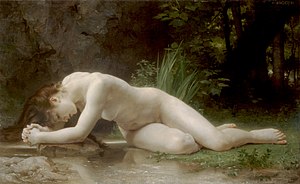Byblis

| Greek deities series |
|---|
| Nymphs |
In
Mythology

Ovid
The most elaborate interpretation of her story is that of
Parthenius
Parthenius of Nicaea[1] cites two versions of Byblis' story, one of which is generally the same as that recounted by Ovid, but ends with Byblis hanging herself with her girdle. In the other version, it is Caunus who instigates the incest, but Byblis still seems to return his affection; Caunus then leaves home before he can lose control over his desires, and Byblis, after a long search for him, makes a noose of her garment and hangs herself. The same version is followed by Conon.[4]
Antoninus
Nonnus
Nonnus depicts Byblis, Caunos and Miletus as the children of Asterius, son of Minos and Androgeneia. In this account, Caunus romantically pursues Byblis with a love song referencing the incestuous relationships between the gods.[5]
All the authors make mention of a spring which was believed to have appeared from Byblis' incessant tears.
The city Byblos in Phoenicia was believed to have taken its name from Byblis.[6]
Caunus and Byblis in art
Between 1706 and 1715, the sculptor
See also
References
- ^ a b Parthenius, Erotica Pathemata 11
- ^ a b Ovid, Metamorphoses 9.446-665
- ^ a b Antoninus Liberalis, Metamorphoses 30
- ^ Conon, Narrations 2
- ^ Nonnus, Dionysiaca 13.546 ff.
- ^ Stephanus of Byzantium, Ethnica s.v. Byblos
- ^ Gerhard Bissell, Haud dubiè Amoris & Psyches imagines fuerunt statuæ istæ, in: Max Kunze, Axel Rügler (ed.), Wiedererstandene Antike. Ergänzungen antiker Kunstwerke seit der Renaissance (Cyriacus. Studien zur Rezeption der Antike, Band 1), München 2003, pp. 73-80.
Bibliography
- Conon, Fifty Narrations, surviving as one-paragraph summaries in the Bibliotheca (Library) of Photius, Patriarch of Constantinople translated from the Greek by Brady Kiesling. Online version at the Topos Text Project.
- Parthenius, Love Romances translated by Sir Stephen Gaselee (1882-1943), S. Loeb Classical Library Volume 69. Cambridge, MA. Harvard University Press. 1916. Online version at the Topos Text Project.
- Parthenius, Erotici Scriptores Graeci, Vol. 1. Rudolf Hercher. in aedibus B. G. Teubneri. Leipzig. 1858. Greek text available at the Perseus Digital Library.
- Publius Ovidius Naso, Metamorphoses translated by Brookes More (1859-1942). Boston, Cornhill Publishing Co. 1922. Online version at the Perseus Digital Library.
- Publius Ovidius Naso, Metamorphoses. Hugo Magnus. Gotha (Germany). Friedr. Andr. Perthes. 1892. Latin text available at the Perseus Digital Library.
- Stephanus of Byzantium, Stephani Byzantii Ethnicorum quae supersunt, edited by August Meineike (1790-1870), published 1849. A few entries from this important ancient handbook of place names have been translated by Brady Kiesling. Online version at the Topos Text Project.
Further reading
- Bell, Robert E. Women of Classical Mythology: A Biographical Dictionary Oxford University Press: 1991.
External links
- Images of Byblis in the Warburg Institute Iconographic Database Archived 2016-03-04 at the Wayback Machine
- Byblis at Theoi Project
- Byblis at Greek Myth Index



